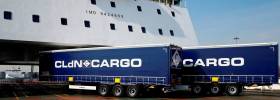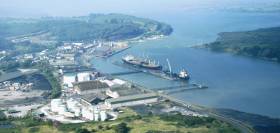Displaying items by tag: Ports and Shipping News
CLdN Ro-Ro Continues to Expand with Pair of Newbuilds
#MoreOrders - CLdN Ro-Ro SA which operates between Dublin and northern European ports has now confirmed two more vessels have been ordered, with options for a further four, through the Croatian shipbuilder Uljanik.
The orders according to Multimodal, follow an ambitious fleet expansion programme announced last September by the Luxembourg based short-sea operator.
Currently CLdN RoRo SA operate 24 modern RoRo vessels, offering in excess of 100 sailings per week between the ports of Zeebrugge, Rotterdam, London, Killingholme, Dublin, Gothenburg, Esbjerg and Porto had previously announced its intention to add 12 new vessels to its fleet over the coming years.
CLdN, whose core services have traditionally been the Continent /UK, which commenced in December 1974, have steadily expanded their geographical presence into new markets, including Ireland, Sweden, Denmark and Portugal in recent years
The initial orders, being built at the Korean yard of Hyundai were described as ‘Game changers’ at the time of order, offering 8,000 lane meters of Ro-Ro capacity. The additional orders are of the same flexible and radical design and offer 5400 lane meters, to accommodate high utilisation of trailers, containers and automotive products in an efficient and environmentally friendly manner, being ‘’LNG ready’’ for straightforward conversion to LNG propulsion.
A company spokesperson described the additional orders as the ‘workhorses’ of the expanding fleet, as they have the durability and flexibility to operate on any of the network and offer complete interchangeability to cater for the demands of the differing trades.
The company sees this as giving a key advantage in this segment and allows it to adapt to customer demands or changing market conditions very rapidly.
These orders fit with CLdN's ambition to develop an additional 70% capacity over the next four years and the Ports Division, C.Ro Ports has now embarked on preparing Terminal infrastructure to be ready for the arrival of the new ships, which will commence delivery Quarter 3 2017.
#SaveElephants - Leaders of the global transportation industry in London this week signed a new declaraction committing major steps to fight criminal wildlife trafficking that has been hailed by the Duke of Cambridge as 'a game changer in the race against extinction.'
Hans Norén, Stena Line’s UK Chairman joined 40 CEOs, Chairmen, and other leaders of airlines, shipping firms, port operators, customs agencies, intergovernmental organisations and conservation charities from around the world to become the founding signatories of the Declaration of the United for Wildlife International Taskforce on the Transportation of Illegal Wildlife Products.
The Buckingham Palace Declaration is the result of a year's worth of meetings, research, and coalition building by the United for Wildlife Transport Taskforce, convened by The Duke of Cambridge and chaired at His Royal Highness's request by Lord Hague of Richmond. Transport representatives on the Taskforce include companies and organisations based in China, USA, UAE, Kenya, the UK and Denmark.
Speaking at the signing of the declaration, The Duke of Cambridge said: "If we allow current trends to continue, there will be no African elephants or rhinos left in the wild by the time my daughter Charlotte reaches her 25th birthday. The poaching crisis is bringing violence, death, and corruption to many vulnerable communities. It threatens to rob future generations of their livelihoods in those regions where wildlife tourism is the core of local economies.
"But this crisis can be stopped. We know where the animals are that we need to protect. We know where the markets for wildlife products are and where awareness, education, and law enforcement need to be improved. And with the Buckingham Palace Declaration being signed today, global transport leaders are saying we know many of the ways wildlife products are being moved from killing field to market place.
"By implementing these commitments the signatories can secure a game changer in the race against extinction. I thank them for their commitment and I invite any other company in the industry to sign up to the Buckingham Palace Declaration and play their part in the fight against the poaching crisis."
Hans Norén said: “Stena Line is fully committed to the vision and dedication of the United for Wildlife International Taskforce and this historic declaration is an extremely important step in helping to put the mechanisms in place to help reduce and hopefully eradicate this illicit trade.
“Over the last 15 months it has been very inspiring to see the collaboration of some of the world’s leading transport organisations and at Stena Line we undertake to do everything within our power to help deliver on the commitments that have been made at the Buckingham Palace Declaration.”
The Buckingham Palace Declaration commits signatories to eleven commitments that will raise standards across the transportation industry to prevent traffickers from exploiting weaknesses as they seek to covertly move their products from killing field to marketplace. The commitments focus on information sharing, staff training, technological improvements, and resource sharing across companies and organisations worldwide. They will also see the world's leading transportation firms assisting those in poorer nations who are in need of expertise and new systems.
The work of the United for Wildlife Transport Taskforce has been strongly supported not only by the transport sector but a number of intergovernmental agencies. Among them the World Customs Organisation, United Nations Development Programme and importantly the Convention on Illegal Trade in Endangered Species of Flora and Fauna (CITES) – the world's regulatory instrument on trade in endangered species.
To learn more about United for Wildlife visit: http://www.unitedforwildlife.org/
IMDO Host Inaugural Ship Commerce Forum
#Forum - The Irish Maritime Development Office (IMDO) hosted an inaugural meeting of the Ship Commerce Forum as the first industry event of 2016. The event was held on Thursday 18th of February at Wilton Park House in Dublin.
The event entitled ‘Maritime Finance: Opportunities for Ireland’ was well attended with a broad spectrum of representatives from professional services firms, financial institutions, international shipping companies as well as representatives from international asset leasing companies based in Ireland.
The round table event was created to initiate an industry focused debate on the current opportunities for Ireland in the maritime finance industry as well as the barriers that exist. Discussion also considered how Ireland could become a centre for maritime finance leveraging on the established leasing support services and expertise available here.
The IMDO Director, Liam Lacey, put forward some broad questions centred around Ireland’s potential as a maritime finance hub. He spoke at length about Ireland’s strength as a location for Foreign Direct Investment and success in other industries, whilst at the same time drawing attention to the opportunities inherent in Ireland’s current underperformance in the Maritime sector.
After a period of intra table debate and presenting back ideas Yvonne Thompson, Tax Partner at PwC gave a summation of the night’s discussion and highlighted some of Ireland’s strengths which make us an ideal location for companies involved in Maritime Commerce.
Growth and development of Ireland’s Maritime Commerce sector is an important initiative which ties into government ambitions outlined in Harnessing Our Ocean Wealth, the IMDO aims to create a forum through which industry views can be channelled and lessons learned.
The forthcoming Harnessing Our Ocean Wealth will take place in Galway on the 1st of July as part of the Marine Institute’s 3rd annual event SeaFest 2016.
Newest Arklow 'Eco-Trader' Takes to Waters for First Sea Trials
#FirstSeaTrials – Newest addition to Arklow Shipping’s Dutch division, Arklow View with her distinctive green hull took to open waters this morning to carry out her first sea trials, writes Jehan Ashmore.
Arklow View with a yard no. of 722 had departed Delfzijl in north-eastern Netherlands to carry out the seatrials off Eemshaven. At time of writing, she was underway with a speed in excess of 12 knots.
The 2,999 gross tonnes Arklow View is based at the Ems estuary port for the trials, but in fact this second in a series of 10 general cargoships was built further inland at Hoogezand near Groningen. Only last month, leadship, Arklow Vale (see photo) made a maiden call to Dublin Port.
The yard responsible for this large order from Arklow Shipping was contracted to Royal Bodewes which is building to their Eco Trader 5,000dwt class series.
The near 87m long vessels or ‘V’ class given their ship naming theme have a single cargo hold and an energy efficient bow. The sisters fly the Dutch flag with a port of registry in Rotterdam, where Arklow Shipping Nederland B.V. are based.
Shipping Review: Maritime Ireland in China, Record Trade Surplus & Shannon Almost Peaks
#ShippingReview – Jehan Ashmore reviews the shipping scene over the last fortnight and where among the stories are outlined below.
At a Sino-Irish business seminar, director of the IMDO Liam Lacey spoke of the 'challenges and opportunities in the aviation and maritime leasing sectors and the implications for Ireland and China’.
Irish exports saw a hike of 20% to just over €111bn in 2015 boosted by the pharma and medical sectors, that drove the trade surplus to a record level.
Shannon Foynes Port Company tonnage throughput in 2015 almost reached the peak of the last decade and is evidence of a recovery taking hold in the regions.
The Department of Transport has issued details of new SOLAS requirements for the verification of the gross mass of shipping containers following concerns in the industry internationally over mis-declaration of container weights.
An Irish-owned ship was detained by Arab coalition forces on suspicion of smuggling arms to Yemen.
A trailing suction hopper dredger is kept busy clearing the shipping channel on Waterford Estuary between Belview Port and the open sea.
Containership Re-floated After Grounding in Southampton Water
#Grounding - APL Vanda, a 14,000TEU capacity containership was being checked for damage on Sunday after a loss of propulsion that left the ship grounded for two hours just outside the port of Southampton.
The NOL-owned vessel was freed from Bramble Bank by tugs and towed into port where it berthed in the early hours.
An APL spokesperson said the ship had been under pilotage when the incident occurred at 2200 hours local time on Saturday evening. The Singapore-flagged ship was freed about two hours later.
For more on the story, click Lloyd’s Loading List.
Afloat adds that APL Vanda (bound for Hamburg) is today still docked in Southampton from where over a year ago the Hoegh Osaka, a car transporter ran aground also on Bramble Bank with a 45 degree list.
Subsequently the vessel shifted position in the Solent before eventually taken into safety with a tow to the major container port.
Exports Rise 20% in 2015 to Over €111bn, Trade Surplus Biggest on Record
#RecordSurplus - A hike of 20% in exports to just over €111bn in 2015 boosted by the pharma and medical sectors, drove the trade surplus to a record level, writes The Irish Independent.
Preliminary figures from the Central Statistics Office showed that exports were €18.4bn higher than 2014.
The figures also showed that the preliminary trade surplus for 2015 was €44bn, which is the largest surplus on record.
To read more click here.
IMDO Director Focuses on 'Challenges and Opportunities' for Maritime Ireland and China
#LeasingSeminar - Irish Maritime Development Office Director Liam Lacey, speaking at the 2016 Sino-Irish business seminar focused on the the 'challenges and opportunities in the aviation and maritime leasing sectors and the implications for Ireland and China’.
The seminar hosted by Dublin City Council and the Ireland China Business Association was linked in with the Chinese New Year celebrations. His Excellency Paul Kavanagh, Ambassador of Ireland to the People’s Republic of China, and His Excellency Jianguo Xu, the Chinese Ambassador to Ireland were in attendance at the Arthur Cox Solicitors sponsored event.
Liam Lacey gave an overview of Ireland’s competitive advantages as a home for maritime commerce and leasing. He also mentioned the company’s forthcoming plans to visit China later in the year with the aim to boost the links between Ireland and China and the two-way trade flows in maritime leasing.
The IMDO produced a Ship Finance Report in 2015 (download PDF) outlining the opportunities in Ireland’s asset leasing international hub to shipping companies who are interested in seeking alternative sources of finance.
Also attending the half day seminar were speakers from industry experts, among them Avolon, KPMG, Arthur Cox, Bank of Ireland, Enterprise Ireland and the IDA.
Drifting Cargoship Rescued off Cornish Coast Completes Voyage
#DriftingCargoship – A drifting cargoship on the way from Rotterdam to Ireland has been rescued off Plymouth by the RNLI, coastguard and a Dutch tug.
The Plymouth Herald writes that the 130m ship suffered engine failure and began dragging anchor off the south coast of Cornwall.
The Samskip Express was drifting three miles off Porthleven but, according to coastguards (on Friday), is now anchored awaiting rescue. It is said to be steady in 35 knot winds and a four metre swell.
A spokeswoman for the Maritime and Coastguard Agency (MCA) said a tug had been sent to the ship and Penlee lifeboat summoned to assist getting a line to the vessel. For more coverage, click here.
In an update, Afloat adds that engine problems with Samskip Express have since been resolved and that the 803 TEU capacity containership was able to continue her voyage from Rotterdam. Last night the vessel berthed in Dublin Port.
The 2006 built containership operated by Samskip based in the Netherlands, though originally an Icelandic company formed in 1990, operate the vessel on a routine ‘feeder’ liner service to Dublin.
Samskip Express is scheduled to make her next departure around noon today bound for Waterford (Belview) the port's main terminal located downriver of the city. Also they operate services between Rotterdam to Belfast and Cork.
Samskip’s Dutch-Irish services form only part of a much wider route network throughout Europe, to northern Russian ports and on the Black Sea and to Georgia. In addition Europe-USA routes to ports on both the Atlantic and Pacific coasts.
Port of Milford Haven Choose 'Three Saints' Names for New Pilot Boats
#NewPilotBoats – According to Milford Haven Port Authority, three of their new pilot boats will be named ‘St Brides’, ‘St Govans’ and ‘St Davids’. The names follow a public competition which attracted almost one hundred entries.
Currently the vessels are being built by Mainstay Marine Solutions at neighbouring Pembroke Port on the Milford Haven estuary, the largest in Wales and one of the deepest natural harbours in the world.
The new boats are designed to be used extensively in heavy weather, capable of operating in swells up to 5 metres in wave height.
Members of the public were asked to submit suggestions for the pilot vessel names and then staff at the Pembrokeshire port voted for their favourites.
The winning names were submitted by Captain Simon Harries who is Operations Manager at Astro Offshore PTE Ltd, an offshore and maritime chartering and brokerage company headquartered in Dubai. He has a long history with the Milford Haven Waterway and is a member of Neyland Yacht Club. Captain Harries said “I chose the names as they are the areas of Pembrokeshire I love most.”
Harbourmaster at the Port of Milford Haven, Bill Hirst, commented “We were delighted at how many entries we received and had a tough job selecting just three. St Brides, St Govans and St Davids have great local relevance and we’ll be proud to put them on the water when they come into service next year.”
The pilot vessels will be driven by the Port’s ‘Storm Heroes’. The marine team found fame on Channel 4’s documentary earlier this year when they were filmed in extreme storms with winds gusting up to 100mph.
A video of one of the launches taking a pilot out to the tanker ‘British Robin’ at St Anne’s Head in January 2015 can be viewed above.
Captain Harries will be invited to take part in a trip on one of the pilot boats he has named when he visits his family in Pembrokeshire next summer.

































































